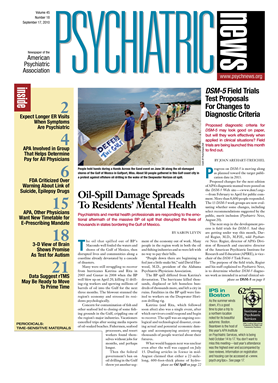In the alphabet soup of acronyms in contemporary medicine—CMS, HHS, DSM, P4P, RBRVS—one of the most important ones you may never think of is the RUC. That's Relative Value Update Committee, and before you nod off to sleep, take note: the RUC has a lot to do with how much you get paid.
The RUC, created by the AMA in 1991, advises the federal Centers for Medicare and Medicaid Services (CMS) about changes in the “relative value units” used in the formula—known as the Resource-Based Relative Value Scale (RBRVS)—for determining physician payment under Medicare.
The 29-member committee—with representatives from the AMA and APA and other specialties—offers recommendations about the relative value units that result in payment for every reimbursable code in the Current Procedural Terminology (CPT) Manual and helps to derive values for newly introduced procedures that receive codes.
And since private insurers may model their reimbursement on the federal program, the RUC's work translates into dollars and cents for physicians everywhere.
The RUC's work, and APA's participation in it, can't be underestimated. Think of it as organized medicine's voice in a process for determining physician payment that might otherwise be more controlled by unfriendly forces.
“The important thing about the RUC is that it is physicians trying to value our codes as opposed to bureaucrats at CMS,” said psychiatrist Ronald Burd, M.D., APA's representative on the RUC and chair of the APA Committee on RBRVS, Codes, and Reimbursement (Committee on Codes).
APA is all over the RUC—in addition to Burd, Allen Anderson, M.D., is alternate representative, and Naakesh Dewan, M.D., and Chester Schmidt, M.D., also members of the APA Committee on Codes, act as advisors.
Burd told Psychiatric News that he believes that APA's Committee on Codes has an important role among APA's components, with seven psychiatrist members and two staff from APA's Office of Healthcare Systems and Financing. Committee members' tenure can last nine years (three three-year terms).
“It's a robust committee,” Burd said. “Due to the fact that so much of what it takes to be successful depends on forming longstanding relationships with the other specialties in medicine on the RUC, we try not to turn over our members too quickly. If we did we'd lose our institutional memory and the relationships we've formed over time. So this is a committee that does long-term work.”
Five-Year Review Under Way
Right now the RUC is in the midst of a critical five-year review of codes that could result in changes in how much psychiatrists and other physicians are paid by Medicare (and by extension by some private insurers). As part of this process, APA has been conducting a survey of “relative work values”—the component of the Medicare payment formula that places a value on procedures performed by clinicians, based on the intensity of work involved in those procedures compared with other medical procedures (see
APA Urges Psychiatric Code Changes).
So what exactly does the RUC do? To answer that, a little history is in order.
Prior to 1989, the government paid physicians in the Medicare program according to their “usual and customary” fees. But to the federal government, working with fixed tax dollars, a usual and customary fee was bound to be an arbitrary one, subject to manipulation and unrelated to the “rational” variables that typically determine price in a market system.
So that year the government adopted the Resource-Based Relative Value Scale (RBRVS), developed by Harvard economist William Hsaio, Ph.D., the goal of which was to assign something approximating a rational value to the services physicians provide to their patients.
Two Key Principles Guide Formula
At the heart of the formula are two principles—it is resource based, meaning it aims to approximate the resources used by a physician to perform any procedure; and it aims for relative equality across procedures that involve similar skills, techniques, and resources.
As Burd explained, “While it may not be possible to derive an absolute value for what a doctor does, you can establish a relative value—that is to say, this procedure is more difficult than that one.”
And so the Relative Value Update Committee, as its name suggests, is largely concerned with assessing the relative value of services and procedures—this service is more time consuming, resource intensive, and difficult than that one.
Burd emphasizes that his role as a “representative” from APA is to act as an impartial arbiter of the relative value of services and procedures offered by specialists of all kinds; he serves on the RUC as a physician and does not advocate for psychiatry.
That obligation puts all of the RUC's representatives in an interesting position, since Medicare works with a fixed dollar amount. “As representatives, we try to make sure that appropriate values are assigned to reflect the relative difficulty of services and procedures,” he said. “But we are all aware that if the RUC recommends an increase in a value for a service provided by one specialty, it necessarily incurs a decrease somewhere else.”
However, Burd noted that APA's “advisors” to the RUC—Dewan and Schmidt—are able to act as advocates for the specialty offering testimony specific to recommendations put forward from psychiatry. The balance of specialty representatives and advisors has resulted in a RUC whose recommendations to the government carry considerable weight.
“CMS does not have to agree to our recommendations,” Burd said. “But the RUC has a 95 percent acceptance rate.”

